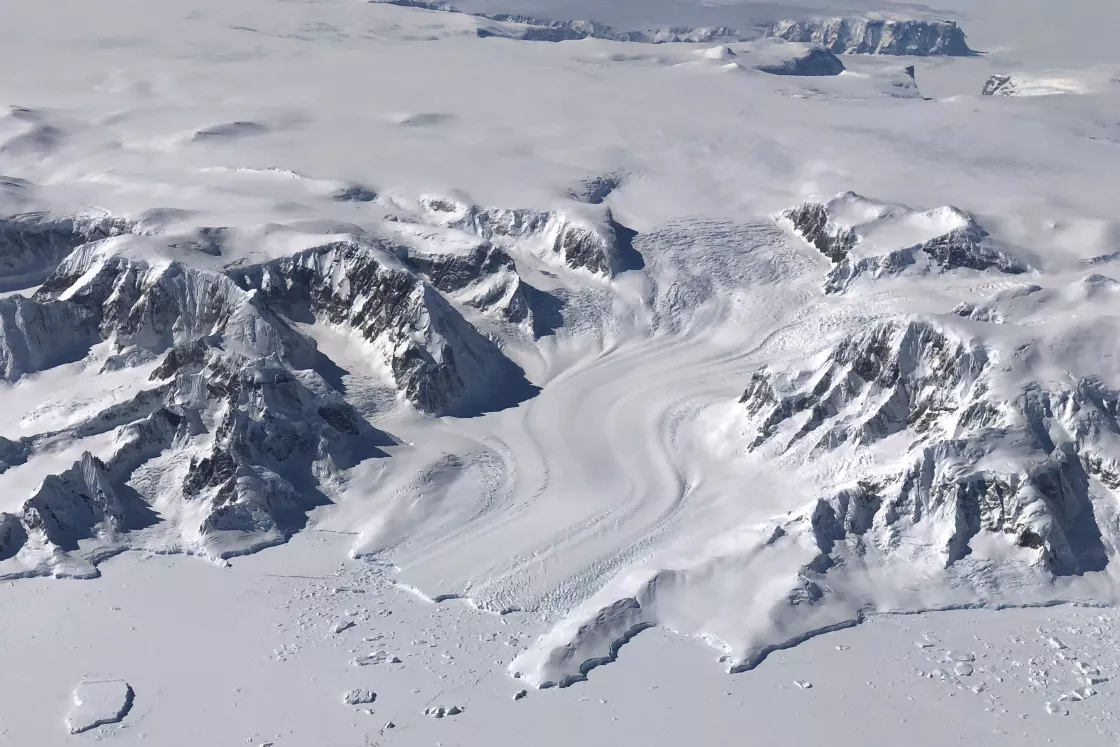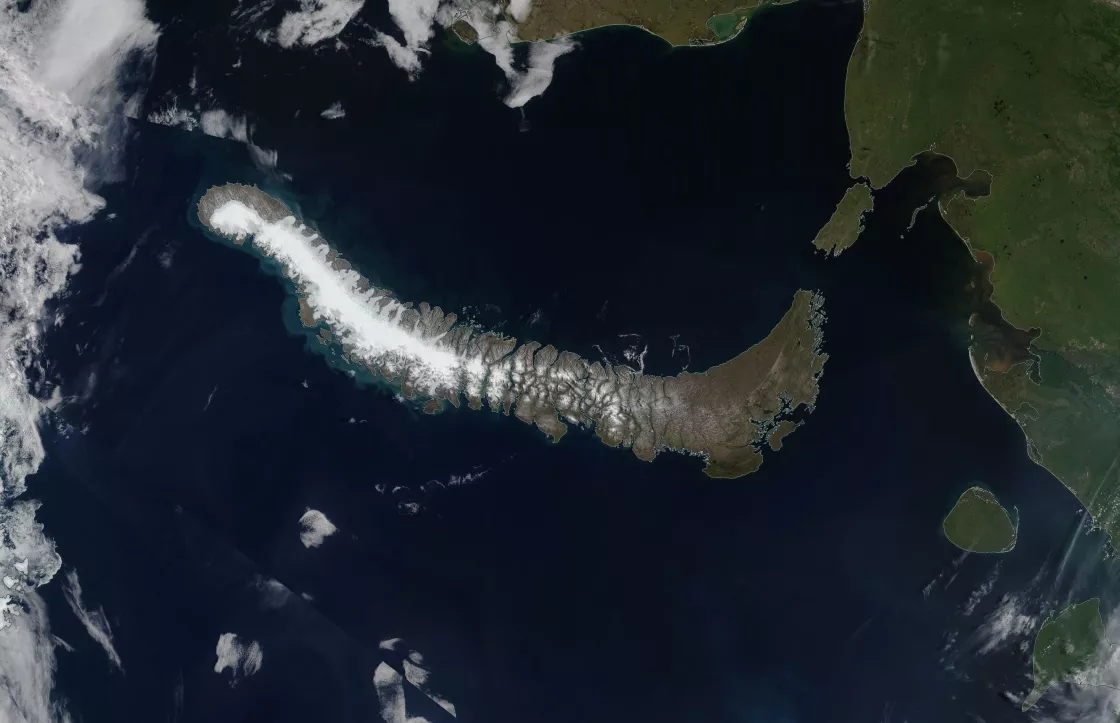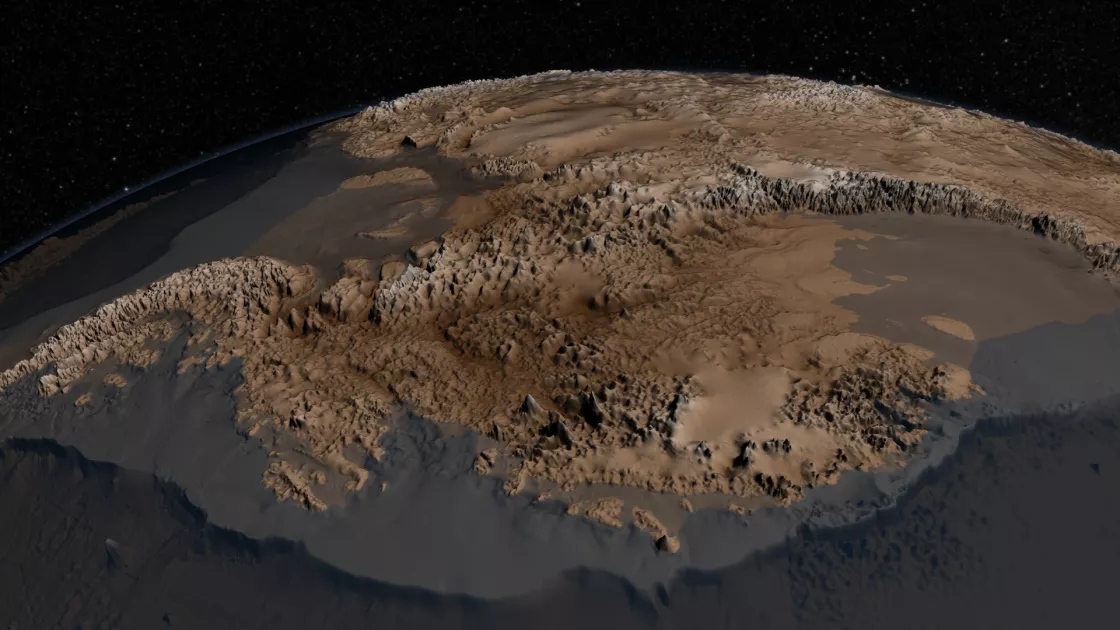Ice Sheets
Overview
What is an ice sheet?
An ice sheet is a mass of glacial land ice extending more than 50,000 square kilometers (20,000 square miles). Ice sheets once covered much of the Northern Hemisphere during a series of Pleistocene Ice Ages. Now, Earth has just two ice sheets: one covers most of Greenland, the largest island in the world, and the other spans across the Antarctic continent. Ice sheets are constantly in motion, spreading out under their own weight in broad domes.
Together, the Antarctic and Greenland Ice Sheets contain more than 99 percent of the land ice and over 68 percent of the fresh water on Earth. Due to human-caused climate change warming the Earth’s air and ocean, the Greenland Ice Sheet has lost substantial ice mass during the 21st century, with annual losses occurring every year since 1998. The Antarctic Ice Sheet is also changing due to the warming climate, but is not yet losing ice as quickly as Greenland or the world’s other glaciers and ice caps. Ice loss in Greenland and Antarctica is already influencing ocean waters and causing sea levels around the globe to rise. If global emissions continue at their current rate, Earth’s ice sheets are vulnerable to even massive more rapid ice loss that could substantially raise increase the rates of sea levels and associated risks and damage.
Earth’s ice sheets act as global water towers, holding water that would otherwise be in our ocean as frozen ice. The Antarctic Ice Sheet covers almost 14 million square kilometers (5.4 million square miles), roughly the area of the contiguous United States and Mexico combined. The Antarctic Ice Sheet measures nearly 4.9 kilometers (3 miles) at its thickest point and in total it contains about 30 million cubic kilometers (7.2 million cubic miles) of ice. If the entire Antarctic Ice Sheet melted, sea level would rise about 58 meters (190 feet). It is useful to note that the Antarctic Ice Sheet is commonly discussed a being comprised of three separate regions, the large East Antarctic Ice Sheet, the smaller West Antarctic Ice Sheet (similarly sized to the Greenland Ice Sheet), and yet smaller Antarctic Peninsula, which reaches up towards South America.
The Greenland Ice Sheet covers about 80 percent of the world's largest island, stretching across 1.7 million square kilometers (656,000 square miles)—an area about three times the size of Texas. At its thickest point, the Greenland Ice Sheet measures over 3 kilometers (1.9 miles) thick and in total it contains about 2.9 million cubic kilometers (696,000 cubic miles) of ice. If the entire Greenland Ice Sheet melted, sea level would rise about 7.4 meters (24 feet).
What is an ice cap?
Ice caps are essentially miniature ice sheets. An ice cap covers less than 50,000 square kilometers (19,300 square miles) and comprises several merged glaciers. Like ice sheets, ice caps tend to spread out in dome-like shapes as opposed to occupying a single valley or set of connected valleys. Due to their smaller size, however, the surface shape and direction of ice movement is generally more reflective of the topography of the landscape underneath the ice than for larger, thicker ice sheets.
Ice caps form in high-altitude polar and subpolar mountain regions. Northern Europe is home to many ice caps such as the Vatnajökull ice cap in Iceland and the Austfonna ice cap in the Svalbard archipelago of Norway, the latter of which is the largest ice cap (in area) in Scandinavia. The largest ice cap in the world is the Severny Island ice cap, part of the Novaya Zemlya archipelago in the Russian Arctic.
Ice caps are also found in mountain ranges like the Himalayas, Rockies, Andes, and the Southern Alps of New Zealand.
How do ice sheets form?
Like a glacier, an ice sheet forms through the accumulation of snowfall in areas where annual snowfall exceeds annual snowmelt. Over thousands of years, layers of snow build up, becoming denser and transforming into glacial ice. The ice thickens to such a point that the pressure of the accumulated ice triggers movement, forming a flowing sheet of ice tens to thousands of meters thick and tens to thousands of kilometers across.
If an ice sheet accumulates the same mass of snow as it loses to melting or flowing into the sea, it remains “in balance.” If there is less snowfall than snow and ice melt in a year, the ice sheet loses mass, while a glacier can gain mass if there is more snowfall in a year than snow and ice melt. Glaciologists refer to this measurement of stability as mass balance, or the net gain or loss of an ice sheet’s mass. Snowfall increases the ice sheet mass. Melting, calving of icebergs, or evaporation of snow or ice decreases the ice sheet mass. Measuring across a year takes into account the seasonal cycle, which can concentrate snowfall or ice melt into different times of year, to produce a more complete picture of year-to-year ice mass change.
How do ice sheets move?
Unlike a glacier, which generally flows in one direction, an ice sheet flows outward in all directions from the center. The Greenland and East Antarctic Ice Sheets are roughly 3,000 to 4,000 meters (10,000 to 13,000 feet) high at their summits. The highest areas on the West Antarctic Ice Sheet and the Antarctic Peninsula are about 2,500 meters (8,200 feet) above sea level.
Ice sheet flow is a function of surface slope, ice thickness, and whether the ice can slide on the bed or land beneath. Near the summit of an ice sheet, where the slope is the shallowest, flow speeds are generally a few centimeters to a few meters per year. Near the coast, ice speeds can reach hundreds of meters or even several kilometers per year, as the ice flows into “outlet glaciers.” Sermeq Kujalleq (previously Jakobshavn Isbræ), one of the fastest moving outlet glaciers in Greenland, has reached speeds as fast as 15 kilometers per year during the twenty-first century. In some instances, fast ice motion can begin farther towards the ice sheet interior, creating “ice streams”: long ribbons of fast-flowing ice bounded by slower-moving ice areas on either side. As outlet glaciers or ice streams move ice out to the ocean, the glacier ice can lose contact with the ground and become a floating ice shelf. This is most common in Antarctica. Ice may also break off from the edge of the glacier or edge of the ice shelf, creating icebergs that float in the ocean.
What is underneath a glacier also influences its speed. Subglacial surfaces can be quite variable, from mud-like till to bedrock to mixed environments.
Ice sheets flow outward from their dome-like centers, where they are generally thickest, and push ice outward towards the ocean. In areas where summer surface melt exceeds winter snowfall, old interior layers in the ice sheet are exposed in summer. Ice sheet surface meltwater may refreeze before it leaves the ice sheet. In other cases, the meltwater can travel through various channels to run out from underneath the ice sheet or pour off its surface. When meltwater travels through the ice sheet, it can travel through moulins (vertical channels), crevasses (deep open cracks), and changing tunnels. If the ice sheet outlet glacier is marine terminating (ending at the ocean), then water will flow directly into the ocean. If, however, the ice sheet outlet is land terminating (ending before the ocean), then water will flow into a river.
For much of the fast-flowing ice in Greenland and Antarctica, ice flow terminates at the ocean, as a tidewater glacier (not fully afloat) or an ice tongue or ice shelf (fully floating thick sheets of ice on the ocean). In these areas, the location of the edge of the ice sheet is sensitive to both ocean conditions and the amount of ice fracturing (crevasses or rifts). With the ice in contact with the ocean, ocean heat may melt the glacier ice. This can include melting the bottom of floating ice tongues or ice shelves, causing thinning and weakening it. Stresses from ice flowing over bedrock or around islands can also cause fracturing, and at the front edge of the ice where it meets the ocean, fracturing can lead to iceberg calving.


